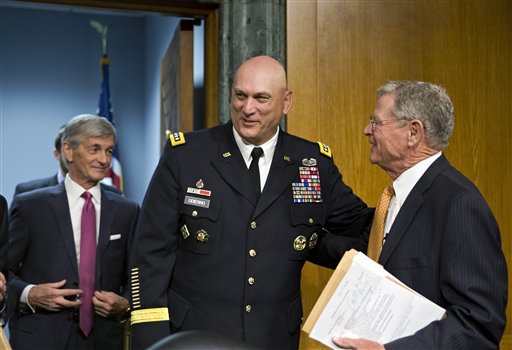By RICHARD LARDNER
Associated Press
WASHINGTON
Senior Army officials warned Tuesday they may have to cut more than 100,000 additional soldiers over the next decade unless automatic spending reductions forcing the military services to slash their budgets are stopped.
Testifying before the Senate Armed Services Committee, Army Secretary John McHugh said the losses would undermine the service’s ability to be prepared for wartime missions. “Today we find our Army at a dangerous crossroads,” McHugh said.
The Army has already planned to trim its ranks from a wartime footing of 570,000 soldiers to 490,000 due to previously planned budget reductions approved by Congress in 2011, according to McHugh said. But if the automatic cuts, known as sequestration, are extended into future years, tens of thousands more soldiers, including members of the Army National Guard and Reserve, will have to be let go due to a lack of money, he said.
Gen. Ray Odierno, the Army’s chief of staff, told the Senate Armed Services Committee that the budget cuts could threaten readiness levels on the Korean peninsula, where military forces remain on high alert after North Korea threatened to attack the United States and South Korea. Sequestration has forced the cancellation of a series of training exercises intended to help prepare soldiers for possible combat there, he said.
Odierno also said the cut of 100,000 additional troops is a minimum number if sequestration is allowed to continue.
Sequestration went into effect March 1. Overall, the Defense Department is required to cut nearly $42 billion by the end of September. If no action is taken to reverse sequestration, the mandated cuts will extend into future years. The Army’s share of the automatic cuts over the next six months is $7.6 billion. In addition to sequestration, the military also has to absorb a $487 billion reduction in defense spending over the next 10 years mandated by the Budget Control Act passed in 2011.
Fewer soldiers won’t translate into cost savings because the departing troops will have to be paid separation benefits, Odierno said. The longer the automatic cuts last, the prospect of using involuntary separations becomes greater, Odierno said.
During an exchange with Sen. John McCain, R-Ariz., Odierno said the Army is heading toward becoming “hollow,” a term used to describe a force that looks good on paper but lacks adequately trained troops and modern equipment.
Two week furloughs for as many as 250,000 Army civilian employees will generate enough savings in the 2013 budget to ensure that deployments for soldiers serving in Afghanistan won’t have to be extended, Odierno said. The decision to go forward with the furloughs as a difficult one, he said.
As many as 700,000 civilian employees at the Defense Department will be furloughed for as long as 14 work days beginning in June, eight fewer days than originally anticipated after Congress gave military officials greater flexibility to apportion automatic budget cuts driving the layoffs.
___
Follow Richard Lardner on Twitter: https://twitter.com/rplardner

COMMENTS
Please let us know if you're having issues with commenting.